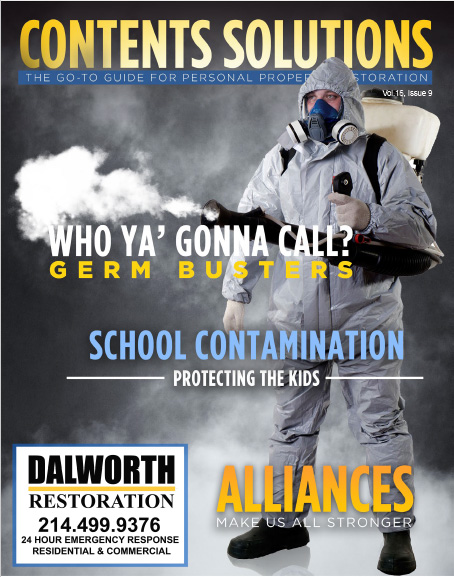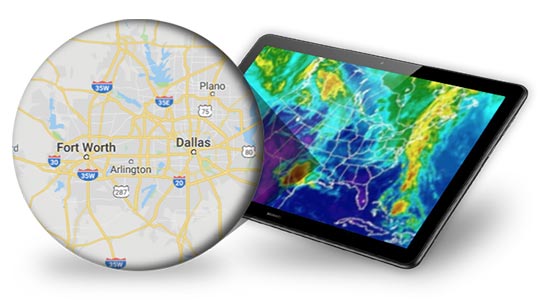24/7 Emergency Services
September 2016: School Contamination - Protecting the Kids

For most contents assignments our first priority is to discover what we can save and restore (not replace). But in contamination jobs, the contents manager has another primary concern – “Are my workers safe in this environment, and what can I do to ensure they are not placed in jeopardy?”
All workers are informed of any hazards, trained in what to do about them and provided with proper personal protection equipment.
A surprising number of companies won’t even take on contamination jobs and an even greater number have no idea how to proceed with them. As an example, you may recall the “Ebola case” in Texas in which a highly contagious disease had infected a home.
The team they sent in was a specially trained contents group. When the state chose a different company (hazmat) to decontaminate a nurse’s home (who had been exposed to the original Ebola patient), the mistakes the second team made – through lack of training – made headlines.
The second hazmat team just threw everything away, including the nurse’s engagement ring – a “rookie” mistake that contents professionals would never have made.
Once the type of contamination is determined, the contents manager has a puzzle to solve. If he (she) recommends “total lossing” much of the contents, the replacement costs for the insurance company can be astronomical.
But trained contents supervisors can often tell at a glance just how deeply the contamination has penetrated various items (couches, clothing, appliances, electronics, ect.) and what sorts of cleaners and decontaminants can guarantee a job well done that actually saves the insurance company massive sums of capital that would otherwise have been wasted.
Next, a staging area must be chosen and the items to be discarded are separated out in order to preclude cross contamination and re-contamination of valuables that are to be restored.
Untrained workers often tackle such jobs with no real plan of action and end up costing the insured and their carriers, significant amounts by failing to determine the extent of the contamination and the appropriate solutions to apply.
Decontamination of an heirloom quilt is a very different process from that used to restore a big screen television which has also been exposed to the contaminant.
Some items can be cleaned and restored onsite, but for those that have to be transported to the contents cleaning facility, extraordinary care must be taken not to leave a trail of infected matter in their wake. Both adjusters and contents pros alike have encountered untrained teams who actually stuff the newly cleaned and decontaminated items back in the same boxes and containers that were contaminated during the initial packout.
Why is that a problem?
Because when the adjuster, contractor or homeowner demands a sampling by an industrial hygienist to determine whether the contaminates have indeed been removed, the very fact that they were transported in corrupted containers virtually guarantees that they will fail the test – a most costly occurrence!
Contents projects managers not only have effective protocols in place, they have the training and experience to improvise in a cost-effective manner when they face potentially expensive challenges.
Contents teams don’t cost – they save.
CONTENTS PROS HELP PREVENT "SOFT FRAUD"
Some otherwise honest homeowners don’t consider the exaggeration of a claim to be any form of dishonesty. And in point of fact, some inflate the worth of various items innocently and without any attempt at prevarication.
Agents and adjusters want to cut down on such activity, but must proceed with caution because they are hoping the policy holder will want to renew with them. It would not do to accidentally insult an honest family or to slow down the entire claims process by investigating every claim, looking for possible fraud.
Of course there are always “anomaly detection” methods – a fellow living in a modern high rise building on the 20th floor, probably does not have a use for a riding lawn mower that was damaged when his apartment was flooded.
But if he claims he does, someone has to go have a look. The contents pros are already on the
scene and are
taking pictures of every room involved in the crisis and of every salient item
in those rooms.
Our digital inventory can show you at-a-glance whether indeed he has a riding lawn mower and if he does, whether it was involved in the resultant flood. This is only one of a dozen ways we can help you clear a claim from your desk and have strong evidence to share with your boss when you are justifying the resolution of a case.
ALLIANCES
MAKE US ALL
If you have been reading Contents Solutions in the past, you have probably noticed that we are ardent believers in our “Million Dollar Database.” If we are faced with a damaged antique Persian rug, we don’t just close our eyes and point at an entry in a Google search to find a top notch rug repair firm – we thoroughly vet them the same way you would investigate us. We speak with other restoration companies, we check with our past customers, we check online reviews and much more.
Some things we do ourselves, for others we consult with our priceless collection of experts that we have been gathering since we first opened our doors.
Actually, it is common for structural restoration companies to bring us in to handle their contents because quite frankly they prefer to focus their expertise on the parts of the job they know best and trust us to deal with the myriad of challenges faced with a homeowner’s or business owner’s valuables.
We are experts in what we do. That is why we can assure you that we can get the job done in a professional, efficient manner. We can help get the paperwork off your desk and keep the inherent contents headaches in check. We are the “go to” professionals for all the items that make a house into a home.
With reports coming in that computer keyboards, doorknobs and cellphones are far more germ-laden than public restroom toilet seats it is obvious why contents specialist are being relied on more and more in the school system to disinfectant classroom and even entire schools where H1N1 or the Norovirus have devastated attendance.
The old standby used to be to wipe everything down with bleach, but can you imagine putting bleach on a doorknob that a second grader is about to turn? Or spraying bleach on a computer keyboard?
Those days are thankfully behind us. Today, once a contents manager is informed as to the type of source of the contaminant, she (he) determines which cleaning and disinfecting compound is best for that type of septicity.
Cleaning is different from sanitizing. Sanitizing is different from disinfecting.
A school maintenance crew can usually handle much of the daily cleaning and sanitizing for the learning facility, but you may remember our article about the university that experienced a serious outbreak and called in the contents pros (along with stacks of disinfecting wipes that they gave the students).
And in a school, the contents pro’s “spray and walk away” technologies are being welcomed with open arms. The thyme-based disinfectants are so human friendly, that one of them is actually “…approved by the US EPA as a high-level disinfectant, fungicide, tuberculocide, and Virucide (against HIV-1) that requires no rising or wiping after application on any surfaces including construction materials.”
Hydroxyls, can “…decompose organic and inorganic gases and air pollutants into carbon dioxide and water.” Used properly, they are effective for killing germs, removing odors and cleaning the air.
Electrolyzed water is harmless to humans, claims to be 50% more powerful than bleach and has proven to eliminate pathogens, grime, grease, mold, mildew and more from any porous or non-porous surface. Plus, it breaks down into ordinary water only minutes after use.
Schools and hospitals have been bringing in the contents pros for some much needed back up during times of contamination crisis.
Schools and hospitals have been bringing in the contents pros for some much needed back up during times of contamination crisis. Not just because they are discreet, but in recognition of the fact that they have the right training, the best technology, and the substances they use are far less toxic that standard disinfectants.
Disruptive Innovation
A little over twenty years ago an article in the Harvard Business Review exposed the business world to the concept of “disruptive innovation.” They explained that a product or service could “disrupt the marketplace” and eventually take its place.
The contents professionals found it a singular honor that so prestigious a learning institution would support a business model that every contents company knos from its first week in the field.
Our unofficial motto was and is, “Adapt, create, proceed.” There would have to be a monumental shift in products and services to have any real impact on contents management. Largely because we are in constant and never ending improvement on every day of every job.











